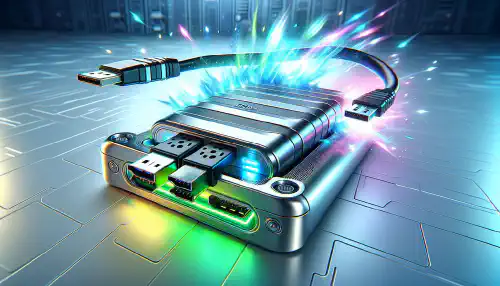eSATA Unveiled: Optimize Your Storage Solutions Today

Table of Contents
External Storage Options: The Versatility of eSATA
eSATA, which stands for External Serial Advanced Technology Attachment, is a versatile external storage option that offers fast data transfer speeds and reliable performance. In this article, we will explore the features and benefits of eSATA, compare it to other external storage options, discuss factors to consider when choosing an eSATA device, examine its applications in professional environments, and speculate on its future in the age of USB-C and cloud storage. Read on to discover the versatility of eSATA and how it can enhance your storage needs.
Key Takeaways
- eSATA provides fast data transfer speeds and reliable performance.
- Compared to USB, Thunderbolt, and FireWire, eSATA offers superior performance for external storage.
- When choosing an eSATA device, consider factors such as compatibility, capacity, and portability.
- eSATA is commonly used in professional environments for video editing, data backup, and audio production.
- The future of eSATA is uncertain due to the rise of USB-C and cloud storage, but it still has potential applications in gaming consoles.
Introduction to eSATA
What is eSATA?
eSATA, or external Serial Advanced Technology Attachment, is a high-speed interface used to connect external storage devices to a computer. It provides a fast and reliable way to transfer data between the computer and the storage device. eSATA offers several advantages over other external storage options, such as USB and Thunderbolt. However, it also has some disadvantages that need to be considered.
Advantages of eSATA
As a cybersecurity expert, I can attest to the numerous advantages of eSATA in external storage options. eSATA offers high-performance RAID storage capabilities, making it an ideal choice for professionals who require fast and reliable data transfer. With eSATA, users can achieve impressive data transfer speeds , allowing for quick backups and efficient file transfers. Additionally, eSATA provides a secure and stable connection, minimizing the risk of data loss or corruption. Its compatibility with existing SATA technology ensures seamless integration with a wide range of devices and systems.
Disadvantages of eSATA
As a cybersecurity expert, it is important to consider the potential vulnerabilities and limitations of eSATA as an external storage option. While eSATA offers several advantages, such as faster data transfer speeds and compatibility with existing SATA drives, there are a few drawbacks to be aware of:
- Lack of Hot-Swapping: Unlike USB or Thunderbolt, eSATA does not support hot-swapping, which means that devices need to be powered off before connecting or disconnecting them. This can be inconvenient in situations where quick and frequent device swapping is required.
- Limited Power Delivery: eSATA does not provide power to connected devices, unlike USB or Thunderbolt. This means that additional power sources or adapters may be required to power external devices, adding complexity to the setup.
- Cable Length Limitations: eSATA cables have a maximum length of 2 meters, which can restrict the flexibility of device placement and limit the distance between the storage device and the computer.
Considering these limitations, it is important to carefully evaluate the specific requirements and use cases before opting for eSATA as an external storage option.
eSATA vs Other External Storage Options

eSATA vs USB
From the perspective of a cybersecurity expert, the comparison between eSATA and USB is crucial in understanding the security implications of external storage options. While USB is widely used and offers convenience, it also poses significant risks due to its susceptibility to malware and data breaches. On the other hand, eSATA provides a more secure connection, making it a preferred choice for professionals who prioritize data protection and confidentiality.
eSATA vs Thunderbolt
From the perspective of a cybersecurity expert, eSATA and Thunderbolt are both popular external storage options. While Thunderbolt offers faster data transfer speeds, eSATA is known for its reliability and compatibility with a wide range of devices. Reliable data transfer is crucial in cybersecurity to ensure the integrity and confidentiality of sensitive information. When it comes to transferring large amounts of data securely, eSATA provides a stable and consistent connection that minimizes the risk of data loss or corruption. In contrast, Thunderbolt may offer faster speeds, but it may not always guarantee the same level of reliability.
eSATA vs FireWire
From the perspective of a cybersecurity expert, the comparison between eSATA and FireWire is an important one to consider. While both options provide high-speed data transfer capabilities, there are key differences that make eSATA a more secure choice.
Firstly, eSATA operates as a direct connection between the external storage device and the computer, without the need for any additional protocols or software. This direct connection reduces the potential attack surface, minimizing the risk of unauthorized access or data breaches.
In contrast, FireWire relies on a more complex protocol that allows for daisy-chaining multiple devices. While this can be convenient in certain scenarios, it also introduces additional vulnerabilities. The daisy-chaining feature can potentially expose all connected devices to a single point of failure or compromise.
To further enhance security, eSATA supports hardware-based encryption, providing an extra layer of protection for sensitive data. This feature ensures that even if the external storage device is lost or stolen, the data remains encrypted and inaccessible to unauthorized individuals.
In summary, when it comes to cybersecurity, eSATA offers a more secure option compared to FireWire. Its direct connection, minimal attack surface, and hardware-based encryption make it an ideal choice for professionals and individuals who prioritize data security.
Choosing the Right eSATA Device

Factors to Consider
When considering an eSATA device for external storage, there are several factors that a cybersecurity expert should take into account:
Data Security: One of the primary concerns for a cybersecurity expert is the security of the data stored on the eSATA device. It is important to ensure that the device supports encryption and has robust security features to protect against unauthorized access.
Compatibility: It is crucial to check the compatibility of the eSATA device with the existing hardware and software infrastructure. This includes verifying if the device is compatible with the operating system, file systems, and any security protocols in place.
Speed and Performance: As a cybersecurity expert, it is essential to consider the speed and performance of the eSATA device. This includes evaluating the data transfer rates, latency, and overall performance to ensure efficient and reliable storage.
Reliability and Durability: The reliability and durability of the eSATA device are vital factors to consider. It is important to choose a device that is built to withstand rigorous use and has a low failure rate to minimize the risk of data loss.
Scalability: Scalability is another important consideration for a cybersecurity expert. It is crucial to choose an eSATA device that can accommodate future storage needs and can be easily expanded or upgraded without significant disruptions.
Cost: Finally, the cost of the eSATA device should be taken into consideration. While it is important to invest in a high-quality and secure device, it is also essential to ensure that it aligns with the budget constraints of the organization.
Considering these factors will help a cybersecurity expert make an informed decision when choosing the right eSATA device for external storage.
Popular eSATA Devices
Popular eSATA devices offer a range of features and capabilities that make them a reliable storage solution for various applications. These devices are designed to provide high-speed data transfer rates, ensuring efficient and seamless data storage and retrieval. With their robust construction and advanced error correction mechanisms, eSATA devices offer a secure and dependable storage solution for cybersecurity experts.
Best Practices for Using eSATA
As a cybersecurity expert, it is crucial to follow best practices when using eSATA for external storage. By implementing these practices, you can enhance the security and reliability of your data storage.
Encrypt your data: Before transferring any sensitive information to an eSATA device, ensure that it is encrypted. Encryption adds an extra layer of protection, making it difficult for unauthorized individuals to access your data.
Regularly update firmware: Keep your eSATA device’s firmware up to date to benefit from the latest security patches and bug fixes. Manufacturers often release firmware updates to address vulnerabilities and improve performance.
Use strong passwords: Set a strong password for your eSATA device to prevent unauthorized access. Avoid using common passwords and consider using a password manager to generate and store complex passwords.
Physically secure your device: When not in use, store your eSATA device in a secure location to prevent theft or tampering. Additionally, consider using a lock or cable to secure the device to your workstation.
Regularly back up your data: Create regular backups of your eSATA device to ensure that you have a copy of your data in case of device failure or data loss. Use reliable backup software and verify the integrity of your backups periodically.
Scan for malware: Before transferring any files to or from your eSATA device, scan them for malware using up-to-date antivirus software. This helps prevent the spread of malicious software and protects your system.
Remember, following these best practices will help safeguard your data and maintain the integrity of your eSATA storage system.
eSATA in Professional Environments

eSATA for Video Editing
eSATA is a versatile option for video editing professionals who require high-speed data transfer and reliable performance. With its faster transfer speeds compared to USB, eSATA allows for seamless editing and rendering of large video files. Additionally, eSATA provides a stable connection, minimizing the risk of data loss or corruption during the editing process. Video editors can benefit from the convenience of eSATA for transferring large video files quickly and efficiently.
eSATA for Data Backup
As a cybersecurity expert, I highly recommend using eSATA for data backup due to its reliable and secure nature. Data backup is a critical aspect of cybersecurity, ensuring that important information is protected in case of data loss or system failure. With eSATA, you can enjoy the following benefits:
- High data transfer speeds: eSATA offers faster transfer speeds compared to other external storage options, allowing for quick and efficient backup of large files and datasets.
- Stable and consistent connection: Unlike wireless backup methods, eSATA provides a stable and reliable connection, minimizing the risk of interrupted backups.
- Compatibility with various devices: eSATA is compatible with a wide range of devices, including desktop computers, laptops, and external hard drives.
To make the most out of eSATA for data backup, consider the following best practices:
- Regular backups: Set up a regular backup schedule to ensure that your data is consistently backed up.
- Encryption: Encrypt your backup data to protect it from unauthorized access.
- Offsite storage: Store a copy of your backup data in an offsite location to safeguard against physical damage or theft.
In conclusion, eSATA provides a secure and efficient solution for data backup. By following best practices and utilizing the high-speed capabilities of eSATA, you can ensure the safety and availability of your important data.
eSATA for Audio Production
eSATA is a versatile option for audio production, offering high-speed data transfer and reliable performance. It provides a secure and stable connection for audio devices, ensuring minimal latency and high-quality sound reproduction. With eSATA, audio professionals can easily transfer large files, such as high-resolution audio recordings or multi-track projects, without experiencing any lag or dropouts.
Future of eSATA

eSATA in the Age of USB-C
As a cybersecurity expert, it is important to consider the implications of eSATA in the age of USB-C. With the increasing popularity of USB-C as a versatile and powerful connectivity option, it is crucial to understand how eSATA fits into this landscape.
eSATA and the Rise of Cloud Storage
As a cybersecurity expert, it is important to consider the implications of eSATA in the context of the rise of cloud storage. While eSATA offers high-speed data transfer and reliable performance, it is essential to evaluate its security implications when compared to cloud storage solutions.
Cloud storage provides a convenient and scalable solution for storing and accessing data remotely. With the increasing adoption of cloud services, organizations and individuals are leveraging the benefits of cloud storage, such as data redundancy, accessibility from anywhere, and automatic backups.
However, it is crucial to note that cloud storage introduces potential security risks. Storing data in the cloud means relying on third-party providers to safeguard sensitive information. This raises concerns about data privacy, data breaches, and unauthorized access.
To mitigate these risks, it is recommended to implement encryption when using eSATA for data storage. Encrypting data before transferring it to an eSATA device adds an extra layer of protection, ensuring that even if the device is lost or stolen, the data remains secure.
Additionally, it is advisable to regularly backup data stored on eSATA devices to the cloud. This provides an additional level of redundancy and ensures that data remains accessible even in the event of hardware failure or loss.
In conclusion, while eSATA offers high-speed and reliable data transfer, it is important to consider the security implications in the context of the rise of cloud storage. Implementing encryption and regularly backing up data to the cloud can help mitigate potential risks and ensure the security and accessibility of data.
eSATA in Gaming Consoles
As a cybersecurity expert, it is important to consider the implications of using eSATA in gaming consoles. While eSATA can provide fast and reliable external storage options, there are certain security risks that need to be addressed.
One of the main concerns with using eSATA in gaming consoles is the potential for malware or malicious software to be transferred through the external storage device. This can happen if the eSATA device is infected with malware or if the console’s security measures are not robust enough to detect and prevent malicious files from being transferred.
To mitigate these risks, it is recommended to follow these best practices when using eSATA in gaming consoles:
- Regularly scan the eSATA device for malware using a reputable antivirus software.
- Keep the gaming console’s firmware and security software up to date to ensure the latest security patches are applied.
- Avoid connecting eSATA devices from unknown or untrusted sources.
- Consider encrypting the data stored on the eSATA device to protect it from unauthorized access.
By following these precautions, gamers can enjoy the benefits of eSATA in gaming consoles while minimizing the potential security risks.
The future of eSATA holds great promise for the world of data storage and transfer. With its high-speed capabilities and compatibility with existing devices, eSATA is poised to revolutionize the way we store and access our data. As technology continues to advance, eSATA will play a crucial role in meeting the increasing demand for faster and more efficient data transfer. Whether you are a professional in need of quick file transfers or a casual user looking to backup your important files, eSATA provides the speed and reliability you need. Experience the future of data storage with SimeonOnSecurity’s Guides, where you can find comprehensive tutorials and expert insights on eSATA and other cutting-edge technologies. Visit our website today to learn more and stay ahead in the world of data storage and transfer.
Conclusion
In conclusion, eSATA is a versatile external storage option that offers several advantages over other options such as USB, Thunderbolt, and FireWire. While it may have some disadvantages, such as limited compatibility and slower data transfer speeds, eSATA remains a popular choice for professionals in various industries. When choosing the right eSATA device, it is important to consider factors such as storage capacity, speed, and compatibility. Popular eSATA devices include external hard drives, solid-state drives, and docking stations. To ensure optimal performance, it is recommended to follow best practices for using eSATA, such as properly ejecting the device and keeping it in a cool and dry environment. In professional environments, eSATA is commonly used for video editing, data backup, and audio production. As technology continues to evolve, eSATA may face challenges from newer options such as USB-C and cloud storage, but it still has its place in the industry. Overall, eSATA provides a reliable and efficient solution for external storage needs.
Frequently Asked Questions
Can I use eSATA devices with my laptop?
Yes, as long as your laptop has an eSATA port or you use an eSATA to USB adapter.
Is eSATA faster than USB?
Yes, eSATA generally offers faster data transfer speeds compared to USB.
Can I hot-swap eSATA devices?
Yes, eSATA supports hot-swapping, allowing you to connect and disconnect devices without restarting your computer.
Are eSATA cables different from SATA cables?
No, eSATA cables are essentially the same as SATA cables, but with a different connector design for external use.
Can I daisy-chain eSATA devices?
No, eSATA does not support daisy-chaining like Thunderbolt or FireWire.
Can I use eSATA for booting my operating system?
Yes, it is possible to use eSATA for booting your operating system, but it requires specific BIOS settings and compatible hardware.



